Raising the minimum age of responsibility: the research evidence
A special long read by Professor Lesley McAra and Professor Susan McVie from the University of Edinburgh.
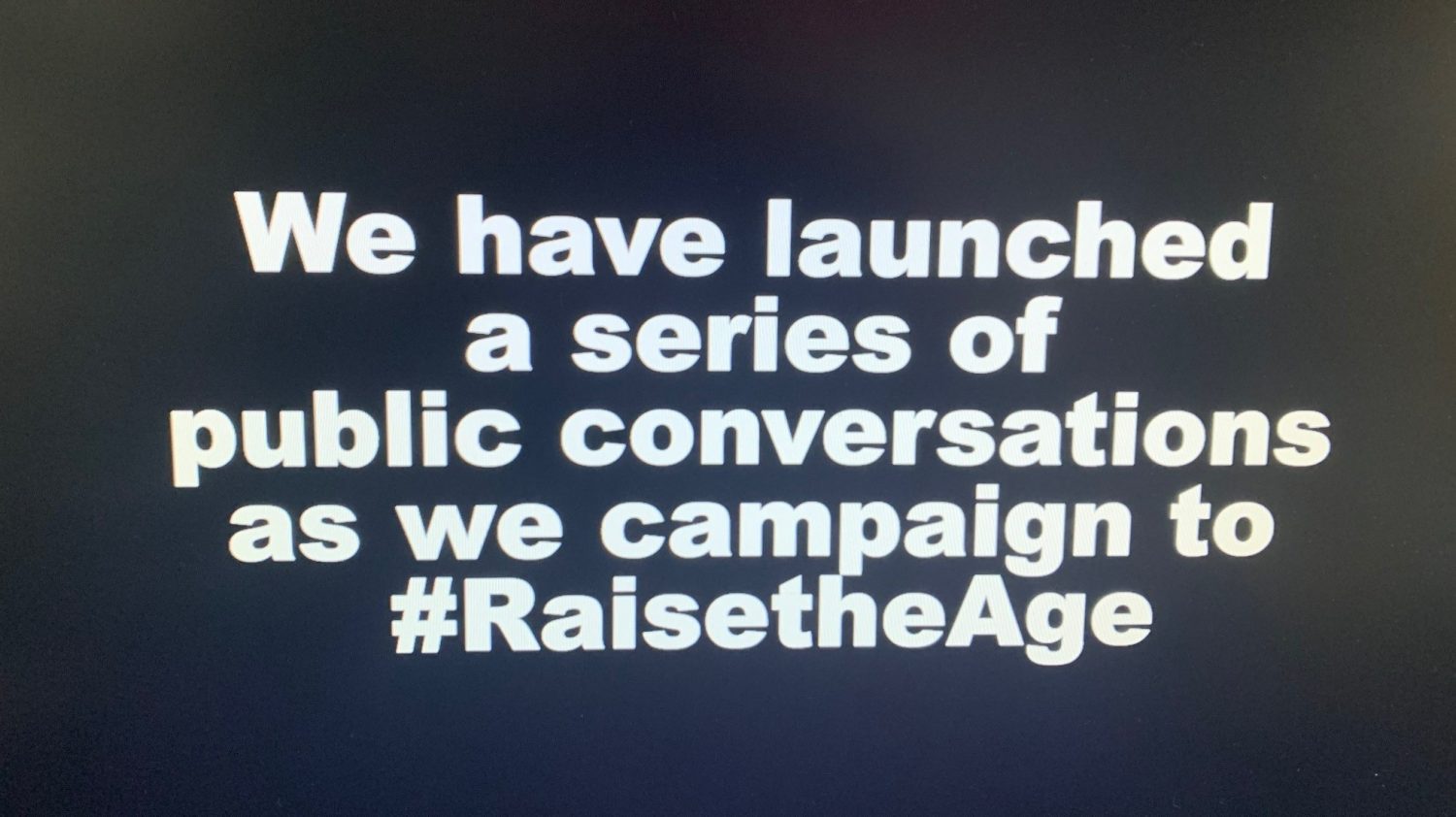
The age of criminal responsibility in Northern Ireland is 10 years old. It remains one of the lowest in Europe and around the world. Organisations such as the Children’s Law Centre, Include Youth, NIACRO and VOYPIC are calling for the age to be raised to 16 in line with UN recommendations.
Read the first post in this series here
Read the second post in this series here
Read the third post in this series here
Read the fourth post in this series here
Read the fifth post in this series here
Read the sixth post in this series here.
Introduction
The minimum age of criminal responsibility (MACR) across all UK jurisdictions (England/Wales and Northern Ireland age 10, Scotland age 12) contravenes the expectations of the United Nation Committee on the Rights of the Child, whose latest guidance specifies that the age should be set at a minimum of 14 and which commends those states where it is 15 or 16 (UNCRC, General Comment No. 24, 2019). In recent years policy makers have paid greater attention to research on brain development and on the impact of early trauma on children and young people. This research has been used in support of new sentencing guidelines in England and Wales and Scotland – in which rehabilitation is being foregrounded as the principal aim in sentencing, and which acknowledge that full capacity (in terms of reasoning and maturation) may not be reached until the mid-20s for some young people.
In this blog, we draw on findings from the Edinburgh Study of Youth Transitions and Crime1 – a longitudinal programme of research on pathways into and out of offending for a cohort of 4,300 people who started secondary education in the City of Edinburgh in 1998. The most recent follow-up of the cohort was at age 35. This Study has formed a core evidence-base for the Scottish Government’s youth justice strategy for over a decade – our findings have been drawn on in support of the Whole System Approach (piloted from 2008 and fully rolled out from 2011), the decisions to raise the age of prosecution to 12 (in 2010) and to raise the minimum age of criminal responsibility from age 8 to 12 (in 2019). Indeed, the Study was explicitly referenced in the policy memorandum accompanying the publication of the enabling legislation raising the MACR: Age of Criminal Responsibility (Scotland) Bill Policy Memorandum (parliament.scot) (Para 62).
Here we set out the research evidence which supports raising the minimum age of criminal responsibility and why, we would argue, that the age should be 15/16. We consider what such changes would mean for responding to children and young people who fall below that minimum age and whose behaviour poses a risk of harm to themselves or to others. And we highlight statistics from Scotland which show how early intervention coupled with diversionary strategies have been associated with major reductions in youth crime.
Research evidence supporting raising the MACR
Our findings show that early involvement in serious and persistent offending, including violence, is strongly associated with poverty and a range of other vulnerabilities, thus demonstrating that deeds are symptomatic of deeper-seated needs2, driven by factors not in the control of young people (McAra and McVie 2012, 2016). They also show that involvement with formal systems of control can be criminogenic in its own right, with early systemic contact leading to a repeat cycle of charges and convictions and serving to inhibit the normal process of desistance that occurs from the mid-teenage years onwards (McAra and McVie 2005, 2007, 2010, 2019). Instead, our most recent findings confirm that desistence from offending is promoted by warm and loving relationships, educational inclusion, and (in early and middle adulthood) employment (McAra and McVie, 2022).
The evidence is as follows:
(i) Deeds are symptomatic of needs
Both descriptive and multivariate analyses highlight statistically significant relationships between deeds and needs – the more serious the deed the deeper the need. Whilst this holds true for all forms of serious offending that we have measured over the course of the Study, here we focus on findings related to involvement in violence (our measure includes assault, robbery and weapon carrying).
Descriptive analysis shows that those involved in violence in comparison with other young people in cohort are significantly more likely to come from the poorest backgrounds, report self-harming behaviours including suicide attempts (especially girls), to have been victims of bullying and of crime, especially violent crime, and to have been excluded from education (either by truancy or formal exclusion). The following two figures show differences between girls and boys, and divide the cohort up into those self-reporting involvement in violence, those who self-report offending but not violence, and those who report no involvement in offending of any type.
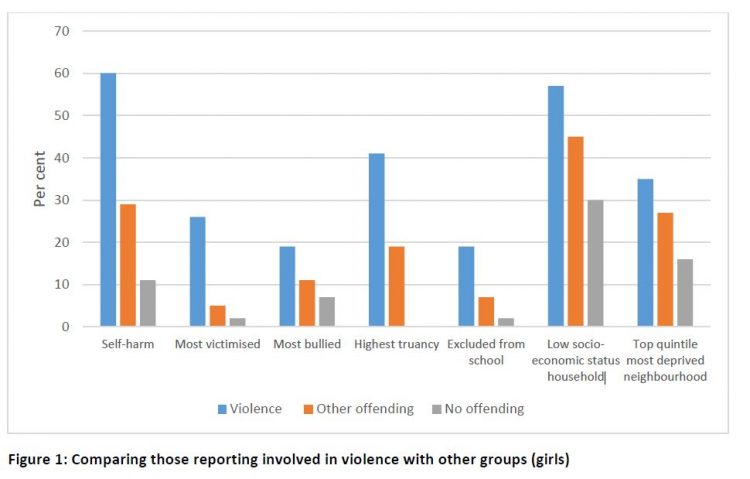
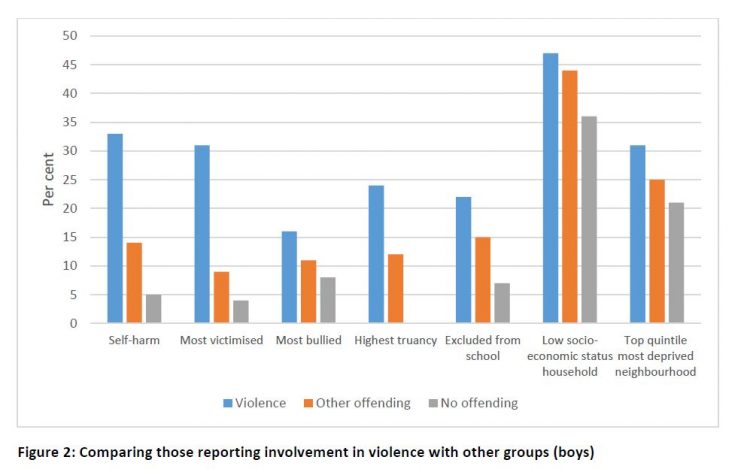
Multivariate analysis enables us to determine which factors remain significant when controlling for each of the others. Our findings show that even when controlling for involvement in violence in earlier childhood (state dependence), violence in the teenage years is predicted by growing up in poverty (as measured by low family socio -economic status and neighbourhood deprivation) and a range of other vulnerabilities, including very high levels of victimisation from crime, families characterised by conflict, poor school attachment and high levels of truancy, as well as early substance misuse (illegal drug and alcohol use) and very high levels of impulsivity.
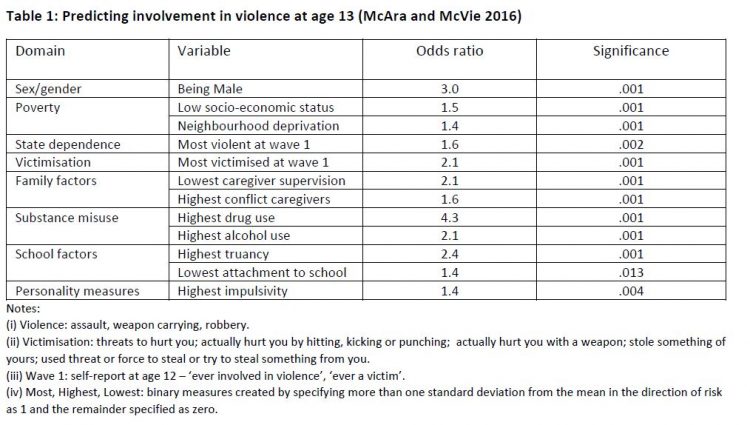
(ii) Formal system involvement can be criminogenic and inhibit desistance
There is strong evidence across all years of our Study that formal system contact begets further and more intensive forms of contact – that being charged, referred into the juvenile justice system, being convicted and being made subject to intervention, all heighten the risk of labelling and being sucked further into the system in later years. And this pattern holds even when controlling for involvement in serious and persistent offending behaviour and a range of other variables which are predictive of system contact.
Table 2 below sets out the results of regression modelling to determine which factors in the early teenage years predicted whether or not a cohort member had a criminal conviction by age 18. As shown, those having early system contact (in the form of referrals to the children’s hearing system for offending by age 12, being formally excluded from school or being care experienced) had almost five times greater odds of a criminal conviction by age 18 than those with no such history, even when controlling for early involvement in serious offending behaviour: much the highest odds in the entire model. Importantly the relationship between early system contact and later criminal conviction holds even with proximal variables in the modelling including contemporaneous involvement in serious offending.
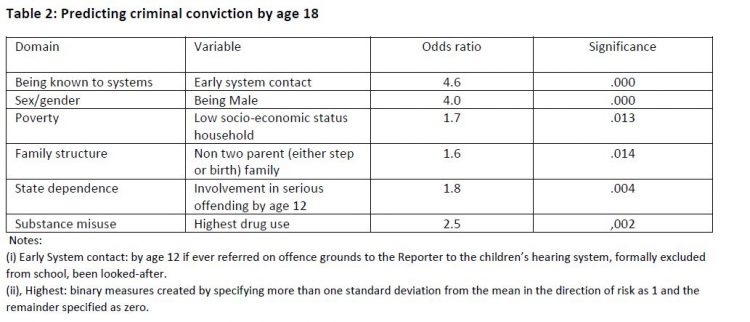
Importantly we also have evidence that the deeper the person penetrates the system the more that their desistance from offending is inhibited. Quasi-experimental analysis using propensity score matching was conducted which allowed individuals who had experienced three progressively more intensive forms of intervention(charged by the police; referral to the Reporter to the children’s hearing system; hearing held and placed on supervision) to be paired up with a control group of similar young people, statistically matched on a range of characteristics (including frequency of self-reported serious offending), who had not had formal system intervention. When outcomes one year later were compared, the only intervention group which had statistically significant higher prevalence of serious offending than its matched controls was the group for which a hearing was held and the young people placed on supervision (Figure 3). Whilst the volume of serious offending had reduced for all of the groups, the only group for which the reduction in offending did not reach statistical significance was the group sucked furthest into the system (Table 3).
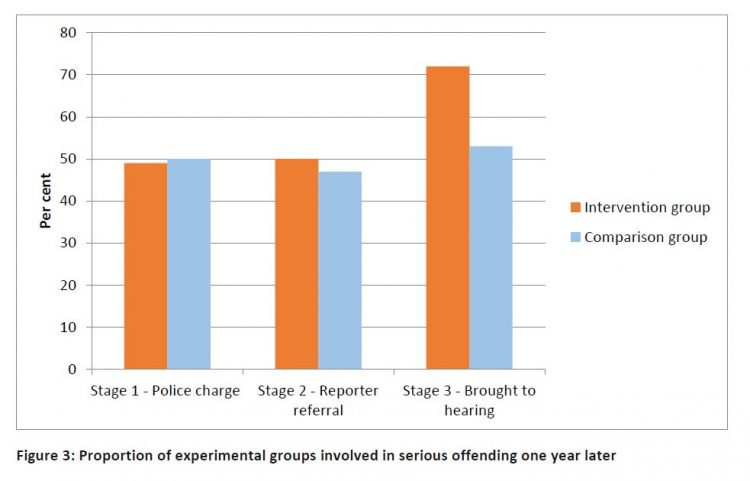

(iii) Relationships, educational inclusion and employment help stop offending
Our most recent phase of research included in-depth interviews with members of the cohort who had had involvement in offending and criminal justice at some point in their teenage and adult years (see McAra and McVie 2022).
Many individuals who were referred to juvenile justice on care and protection grounds in early childhood described how they became increasingly viewed as offenders by agencies during their teenage years. Outcomes for these care-experienced individuals were the most negative, with lives consistently blighted by poverty, mental health and drug problems, poor educational experiences, and periods of unemployment. When agencies did make a positive difference in people’s lives, it was generally felt to be due to an individual worker or carer with whom a strong relationship had been built.
For those encountering the criminal justice system for the first time in the mid to late teenage years, contacts with institutions (including the police and the courts) appeared to have only limited, indeed almost fleeting, impact on their behaviour: a hazard, that was initially alarming but quickly normalised. Conversely key factors identified by interviewees which helped them stop offending were loving partners, children, and jobs which they valued. Such outcomes often depended on educational inclusion, cutting ties with friendship groups from the teenage and early adult years, and, in some cases, downplaying earlier involvement in offending – a reconstruction of identity.
We present here a small selection of quotes to evidence these points (more detailed analysis and evidence can be found in McAra and McVie 2022).
Criminal justice system: a hazard to be negotiated:
Courts: Well I haven’t really seen that I broke the law and the worst they could really do is give me a fine. So, I wasn’t really bothered to be honest. (Interviewee 561)
Probation: To be honest I didn’t learn anything from it, I was just surrounded by other people that committed crime…I didn’t find it as much as a punishment, it was just something I had to do. (Interviewee 831)
Nurturing relationships with individual key workers/foster carers can make a difference:
My foster carers, I still keep in touch with them…they played quite a big part in our lives. If it wasnae for them. I don’t know how I would’ve turned out to be honest’. (Interviewee 210)
My social worker at the time, she was lovely… She was really, really nice, but she ended up giving up being a social worker just because, for her, she’s not been able to help people. I remember me really impacting on her ‘cos I kept trying, but the odds were against, and you keep trying and trying. (Interviewee 101)
What supports pathways out of offending:
Going home, dirty hands, clean money. (Interviewee 578)
I’ve got a really good job…I’ve got a really nice partner, I’ve got two kids, you know we’ve got money, we’re getting ready to buy a house. I probably wouldn’t be doing that if I had still been in close contact with these people… I slowly turned it into a positive, when I stopped speaking to them. (Interviewee 676)
I think finding a job that I really enjoy…. Then finding a partner who right from day one we got on brilliantly together. To then feeling comfortable enough to … have children and now children that, I just look at them, and there’s no way I’d ever want to be run the risk of ever getting sent away from them. (Interviewee 35)
What might raising the MACR mean for those below the set age who are involved in harmful behaviour?
A major concern of many consultees to any proposal to raise the MACR, is what would happen to those young people who fall below the age of criminal responsibility and yet who are involved in behaviours which are (either or both) harmful to themselves and others. It is important to stress that in Scotland, as in other jurisdictions where the age of criminal responsibility is higher (such as many Scandinavian countries), these forms of behaviour will trigger interventions but ones which are welfare-based, and do not criminalise children and young people. It is also important to stress that diversion too from formal measures must be to well-resourced services and support for children, including educational, restorative, and other structured activity.
Where jurisdictions have adopted a holistic approach to supporting the development and flourishing of children and young people, this has meant investing heavily in early forms of intervention – parenting support, early years education and support for educational inclusion in the primary and secondary years – as well as youth work and related services. There is growing evidence that where a Whole System Approach has been adopted (with the capacity to divert those who come into conflict with the law at each stage of the youth justice process), that this is associated with reductions in youth crime. Whilst practices across Europe have taken many forms, many of those jurisdictions which have embraced diversion show a declining youth justice client group (see section on Scotland below, also see McAra and McVie 2019 for a cross-jurisdictional review of data).
A Scottish success story?
In the final part of the blog we present evidence from official statistics showing the strong association between the implementation of early intervention and diversionary strategies coupled with the raising of the age of prosecution on youth crime. Figures 4 to 6 show major reductions in referrals on offence grounds to the Reporter to the children’s hearing system (by 88% since 2008), criminal convictions for 16 and 17 year olds (by 90 % since 2008), and use of custody for those aged 16 and 17 (by 82% since 2008, the lowest for at least 50 years). Whilst some of these trends began slightly earlier than full implementation of all of these measures it is striking that the rate of reduction accelerated in the years post 2008 up to the mid-2010s, with a slight levelling off in the period since then.
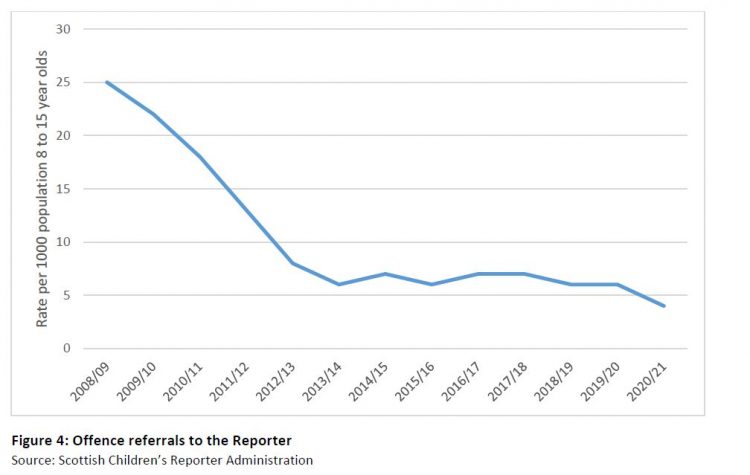
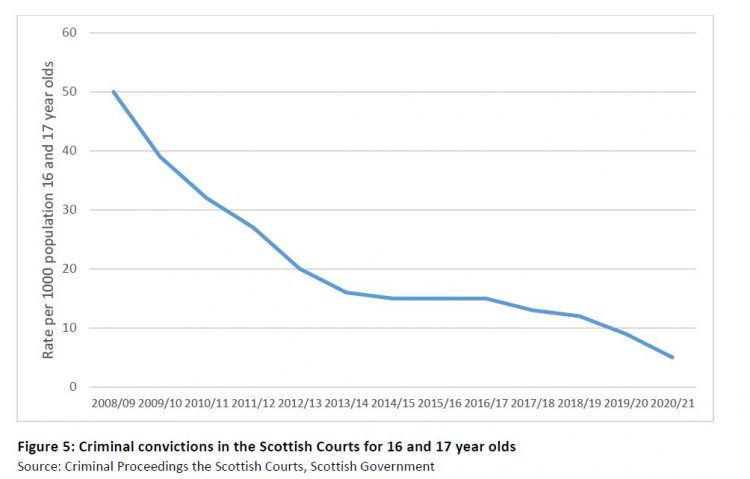
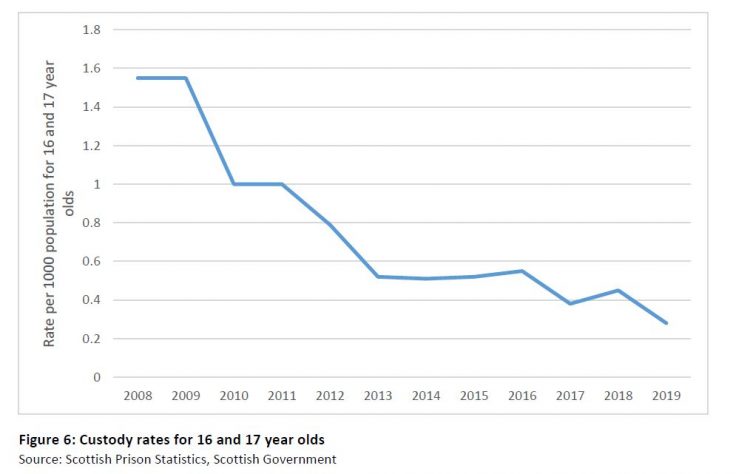
Concluding reflections
Debates around raising the age of criminal responsibility go to the heart of what it means to deliver justice to children and young people in conflict with the law. If we want to prevent crime and enhance community safety, then it behoves us to avoid the criminalisation of children and tackle the structural and relational deficits which shape the lives of those who become involved in serious and persistent offending, deficits over which they have limited control. We are conscious that the findings from the Edinburgh Study make difficult reading for policy-makers: they suggest that the criminal justice system is more likely to damage people and inhibit their capacity to achieve the modest social norms that support pathways out of offending. Critically they suggest that the answer is not to punish more or more effectively, but that a safer society is best created through investment in the early years that brings together health, education and economic policy and more – cross portfolio working. And it is best created through investing in people, nurturing, valuing and paying well teachers, nurses, social workers, prison and police officers. Only then can we truly say as a society that we have been tough on crime!
Footnotes
1 The Edinburgh Study has been funded by the ESRC (R000237157, R000239150), The Scottish Government and the Nuffield Foundation. Data on our cohort has come from a range of sources: self-report questionnaires; semi-structured interviews; a parents’ survey; a teacher questionnaire on strengths and difficulties; official records from the children’s hearing system; social work; school and criminal conviction data; and a geographic information system drawing on census and police recorded crime data. Further details of the Study, including the most recent report on Phase 8 (follow-up at age 35) can be found here: Home – | Edinburgh Study of Youth Transitions and Crime
2 This phrase echoes the ‘Kilbrandon philosophy’ which formed the founding ethos of the Scottish Children’s Hearing System – it emphasises the importance of avoiding criminalisation, of dealing with troubled and troublesome children in the same way, and focusing on an educational model of care aimed at addressing the child’s needs (Kilbrandon 1964).
References
McAra, L., and McVie, S. (2005) The Usual Suspects? Street-life, Young Offenders and the Police, Criminal Justice, 5 (1): 5 – 36
McAra, L. and McVie, S (2007) “Youth Justice? The Impact of Agency Contact on Desistance from Offending”, European Journal of Criminology, Vol. 4, No. 3 pp 315-345
McAra, L., and McVie, S. (2010) Youth Crime and Justice: Key Messages from the Edinburgh Study of Youth Transitions and Crime, Criminology and Criminal Justice 10: 211-230
McAra, L. and McVie, S., (2012) Negotiated Order: A Groundwork for a Theory of Offending Pathways, Criminology and Criminal Justice, 1(4): 347-376
McAra, L. and McVie, S. (2016) Understanding Youth Violence: The Mediating Effects of Gender, Poverty and Vulnerability, Journal of Criminal Justice DOI: 10.1016/j.jcrimjus.2016.02.011
McAra, L. and McVie, S., (2019), Transformations in Youth Crime and Justice Across Europe: Evidencing the Case for Diversion, in Goldson, B. ed., Juvenile Justice in Europe, pp 209-253, London and New York: Routledge
McAra, L. and McVie, S. (2022), Causes and Impact of Offending and Criminal Justice Pathways: Follow-up of the Edinburgh Study Cohort at Age 35, Report for the Nuffield Foundation




